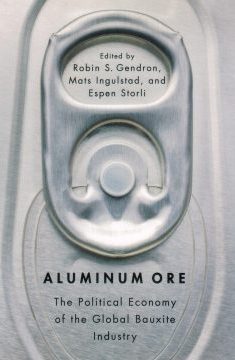Read this book and you’ll never think the same way again in reaching for a roll of kitchen foil to cover your barbecued chicken. Authors in searing detail document aluminum production from open-pit Third World bauxite mines to toxic refineries to the $2.90 kitchen convenience. The supply chain is coldly efficient.
Aluminum Ore is stark and meticulously researched. Authors Robin Gendron of Nipissing University and two faculty members at Norway’s University of Science & Technology tell the very human story of an everyday commodity we only think we know.
Making one ton of aluminum requires 1,380 tons of water, produces 85 tons of industrial waste and 10 tons of greenhouse gas emissions. Its main source, bauxite, can only be refined through heating and cooling with caustic soda in a process that annually produces 120 million tons of toxic discharge the industry calls “red mud.” In Hungary, the 2010 collapse of a red mud reservoir at an alumina plant flooded villages, caused 131 casualties and nearly poisoned the Danube. In India, bauxite labourers are paid $2 a day and hundreds of thousands of villagers have been displaced to make way for strip mines and refiners’ plants.
“Bauxite has never been sold for a price commensurate with the damage done by mining it,” notes Aluminum Ore.
Best known as the misnamed tin foil, aluminum refined from bauxite has a long and compelling history rife with conflict. The process was patented in 1888. By 1916 a single corporation Aluminum Company of America exercised “autocratic control” over the industry, as one U.K. cabinet memo put it. Alcoa survived three anti-trust investigations between 1912 and 1937. Its largest stockholder Arthur Vining Davis is recalled not as a ruthless tycoon but the philanthropist who created a namesake charity best known for subsidizing TV shows on PBS.
Aluminum in early years was costly and had no obvious indispensable purpose. As late as 1914 the French Army used it mainly to manufacture uniform buttons. With technology it became a strategic raw material, a secret weapon “the supply of which could possibly decide the outcome of wars,” as Aluminum Ore puts it.
How indispensable? In 1935 France, then Europe’s largest bauxite miner, slapped export controls on sales to Nazi Germany. In 1940 U.S. President Franklin Roosevelt dispatched troops to Dutch Guiana to guard bauxite mines that accounted for two-thirds of the supply used to produce aircraft: “If this supply were interrupted in any way it would most seriously delay the production of aircraft which are so urgently needed,” FDR said.
Aluminum ore was rated so crucial to victory Germans dispatched U-boats to the sunny Caribbean in 1942 to sink freighters loaded with bauxite from Trinidad. Nazi wolf packs destroyed nearly a quarter of the bauxite fleet, prompting U.S. Army Chief of Staff George Marshall to write: “The losses by submarines off our Atlantic seaboard and in the Caribbean now threaten our entire war effort.”
Aluminum Ore recounts all this turmoil, environmental disaster and human conflict in a crisp narrative. A simple roll of kitchen foil will never look the same again.
By Holly Doan
Aluminum Ore: The Political Economy of the Global Bauxite Industry, edited by Robin S. Gendron, Mats Ingulstad & Espen Storli; University of British Columbia Press; 400 pages; ISBN 9780-7748-2533-7; $34.95






